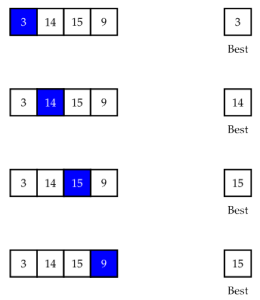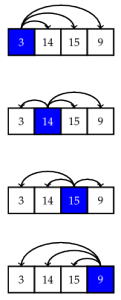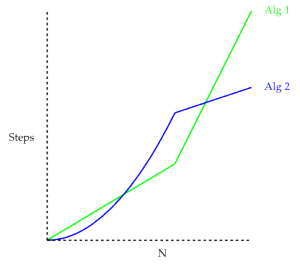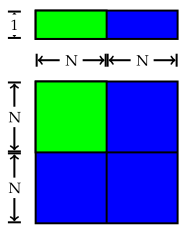Hello everyone!
Sorry for missing last week's post. I was a bit busy graduating. It shouldn't happen again.
I mentioned back in my first post that one of my interests is algorithm design. This week, I'd like to talk a bit about what that means. The word "algorithm" gets thrown around a lot in TV shows, movies, and science journalism, and quite often, it's horribly misused. So let's define our terms before we go further: an algorithm is a sequence of steps which can be followed to turn one form of data into another.
That's kind of an abstract definition, though, so let's dive in with an example. Let's say we have a list of numbers, and we'd like to know which is the largest. How might we go about this? One way to do this is to just walk through the list and keep track of the largest number we've seen. So in the list below, we start by saying the  is the largest number. Next, we check the
is the largest number. Next, we check the  and see that it's larger than
and see that it's larger than  , so it's the largest so far. We then check the
, so it's the largest so far. We then check the  and see that it's even larger. Finally, we see that the
and see that it's even larger. Finally, we see that the  isn't larger, so
isn't larger, so  is still the largest we've seen.
is still the largest we've seen.
The solution above is good, but there are other ways to solve the problem. Another approach we might take is to check if each element is the largest. To do so, we compare each element against every other element, and if nothing is larger, we declare it the largest. So in the example below, we compare  with every other element and find that there's something larger (namely
with every other element and find that there's something larger (namely  ). Then we compare
). Then we compare  against every other element and find that
against every other element and find that  is larger. Then we compare
is larger. Then we compare  against everything and see that it is the largest. We could stop there, but for the sake of completeness, we also check to see that
against everything and see that it is the largest. We could stop there, but for the sake of completeness, we also check to see that  isn't the largest.
isn't the largest.
Both of the algorithms described above can find the largest element of a list. If all that mattered was getting the answer, we might say they were equally good. But if we want to use these in the real world, we also need to take speed into account, particularly when the list gets very long. So how do we quantify speed? One way we could do it to just run the two algorithms on a computer with some test data. We would get curves like the ones below for the time taken. But this can be very misleading. How do we know the trends we see with small data sets continue when the data set gets larger. In other words, how do we know that the graph above isn't just a part of the graph below?
But this can be very misleading. How do we know the trends we see with small data sets continue when the data set gets larger. In other words, how do we know that the graph above isn't just a part of the graph below?
We answer this by counting the number of steps taken for each algorithm. In general, an algorithm that takes more steps needs more time to run, so we want to use as few steps as possible. Let's say our list has length  . The first algorithm compares each element of the list against the largest we've seen thus far. That's one comparison for each element, for a total of
. The first algorithm compares each element of the list against the largest we've seen thus far. That's one comparison for each element, for a total of  comparisons. The second algorithm compares each pair of elements of our list, but doesn't compare each element with itself. There are
comparisons. The second algorithm compares each pair of elements of our list, but doesn't compare each element with itself. There are  such pairs that we can make, so the second algorithm takes at most
such pairs that we can make, so the second algorithm takes at most  steps.
steps.
Generally speaking, it's not necessary to get the exact number of steps needed. What's more important is how the number of steps scales as the problem size increases. For instance, what happens if we double the length of the list? For the first algorithm, we need at most  steps, and doubling
steps, and doubling  doubles the time needed. However, for the second, we need
doubles the time needed. However, for the second, we need  , which is approximately
, which is approximately  steps, and doubling
steps, and doubling  quadruples
quadruples  , so the time needed quadruples. We can see this below: doubling
, so the time needed quadruples. We can see this below: doubling  doubles the area of the first green rectangle (
doubles the area of the first green rectangle ( ) but quadruples the area of the second (
) but quadruples the area of the second ( ).
).
It turns out the most useful measure of how an algorithm scales is the largest power of  in the number of steps, which we denote with an O (pronounced Big-Oh). There's a more rigorous definition, but for now, this will do. The largest power of
in the number of steps, which we denote with an O (pronounced Big-Oh). There's a more rigorous definition, but for now, this will do. The largest power of  in
in  is
is  , so we say that the first algorithm is
, so we say that the first algorithm is  . The largest power in
. The largest power in  is
is  , so the second algorithm is
, so the second algorithm is  . The lowest powers of
. The lowest powers of  scale better as
scale better as  gets large, so an
gets large, so an  algorithm is generally faster with large data sets than an
algorithm is generally faster with large data sets than an  algorithm. Thus, we would call the first algorithm better than the second. This method, known as asymptotic analysis, is really the cornerstone for the study of algorithms. I'll explain this in a lot more detail in future posts, so don't worry if you didn't get it here.
algorithm. Thus, we would call the first algorithm better than the second. This method, known as asymptotic analysis, is really the cornerstone for the study of algorithms. I'll explain this in a lot more detail in future posts, so don't worry if you didn't get it here.